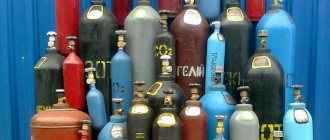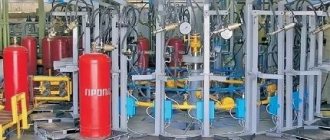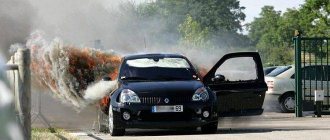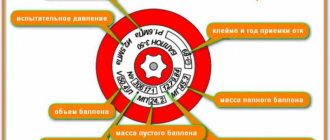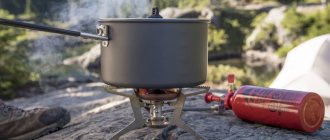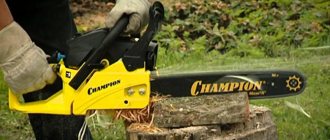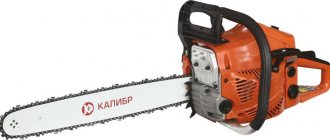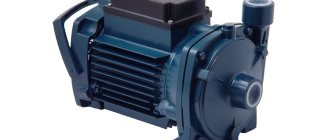Author of the article:
Muzyko Tatyana Andreevna - lawyer.
Gas cylinders are pressure containers containing gas.
They pose a certain threat to humans, therefore the legislation imposes rather strict requirements for maintenance and maintenance.
A number of mandatory requirements must be observed to prevent tragic situations from occurring.
Legislation
- Order of Rostekhnadzor dated March 25, 2014 No. 116 “Industrial safety rules for hazardous production facilities that use equipment operating under excess pressure” in Chapter 5 establishes a requirement for the maximum service life of vessels.
- GOST 15860 “Welded steel cylinders for liquefied hydrocarbon gases at pressures up to 1.6 MPa” describes technical parameters depending on volume, test methods.
- GOST 949-73 “Steel cylinders of small and medium volume for gases at 200 kgf/cm2”.
- GOST R ISO 11439-2010 “High pressure cylinders for storing natural gas as fuel on a vehicle. Technical Specifications" defines the rules for operating gas-powered vehicles.
- PB 10-115-96 “Rules for the design and safe operation of pressure vessels” are mandatory for organizations of all forms.
List of documents that the driver of a vehicle equipped with gas equipment must have with him
The driver is required to present documents for the installed equipment during an inspection by a traffic police inspector, at the request of a gas station employee, when passing a state technical inspection:
- vehicle registration certificate, which contains a note indicating the legal installation of gas equipment;
- certificate form 2b;
- cylinder nameplate with inspection marks;
- passport with data corresponding to the container plate.
Recertification of the cylinder and checking of gas equipment are carried out in order to ensure the safe operation of a vehicle with gas cylinder equipment. The lack of documentary evidence can cause not only fines in the amount of 500 rubles, but also other troubles.
Expiration dates of cylinder and gas
The legislator has made the manufacturer responsible for setting the shelf life of the container. The only condition is that it should not exceed 20 years.
Dear readers! To solve your problem right now, get a free consultation
— contact the lawyer on duty in the online chat on the right or call: +7 (499) 938 6124 — Moscow and region.
+7 (812) 425 6761 — St. Petersburg and region. 8 (800) 350 8362 - Other regions of the Russian Federation You will not need to waste your time and nerves
- an experienced lawyer will solve all your problems!
If a product exceeding this threshold is subject to certification, it is subject to withdrawal.
For example, a car tank with methane gas is good for 15 years. A household propane cylinder for a burner or gas stove will last 20 years.
Metal composite and aluminum containers produced before 2014 are good for 10 years. Aluminum after November 2014 – 20 years. The Chelyabinsk Pipe Rolling Plant produces products in accordance with GOST, they can be used for 20 years.
Thus, gradual replacement will be carried out.
The content (gas) also has a period when its characteristics meet regulatory requirements.
| Kinds | Material | Volume, l | Filling | Gas shelf life, years | ||||
| metal | composite | 5 | 12 | 27 | 50 | |||
| Industrial | + | + | + | + | + | + | Oxygen | 1,5 |
| Hydrogen | 3 | |||||||
| Helium | 2 | |||||||
| Argon | 1,5 | |||||||
| Hydrogen | 1 | |||||||
| Household | + | + | + | + | + | + | Propane | Is not limited |
| Automotive | + | + | + | + | Propane | Is not limited | ||
| + | + | Methane | 15-25 | |||||
| Tourist | + | + | + | Propane | Is not limited | |||
| + | Butane | 10 | ||||||
| Medical | + | + | + | + | + | + | Oxygen | 1,5 |
Russia
The following scheme for painting and marking compressed gas cylinders has been adopted in Russia:
| Gas | Cylinder color | Lettering color | Stripe color | Example |
| Nitrogen | Black | Yellow | Brown | Nitrogen |
| Ammonia | Yellow | Black | — | Ammonia |
| Argon raw | Black | White | White | Argon raw |
| Argon technical | Black | Blue | Blue | Argon technical |
| Argon pure | Grey | Green | Green | Argon pure |
| Acetylene | White | Red | — | Acetylene |
| Butylene | Red | Yellow | Black | Butylene |
| Hydrogen | Dark green | Red | — | Hydrogen |
| Helium | Brown | White | — | Helium |
| Nitrous oxide | Grey | Black | — | Nitrous oxide |
| Oxygen | Blue | Black | — | Oxygen |
| Blue | Black | — | Medical oxygen | |
| Oil and Gas | Grey | Red | — | Oil and Gas |
| Sulfur dioxide | Black | White | Yellow | Sulfur dioxide |
| Hydrogen sulfide | White | Red | Red | Hydrogen sulfide |
| Compressed air | Black | White | — | Compressed air |
| Carbon dioxide | Black | Yellow | — | Carbon dioxide |
| Phosgene | Protective | Black | Red | Phosgene |
| Freon-11 | Silver | Black | Blue | Freon-11 |
| Freon-12 | Silver | Black | — | Freon-12 |
| Freon-13 | Silver | Black | Two red | Freon-13 |
| Freon-22 | Silver | Black | Three yellow | Freon-22 |
| Chlorine | Protective | Black | Green | Chlorine |
| Cyclopropane | Orange | Black | — | Cyclopropane |
| Ethylene | Violet | Red | — | Ethylene |
| all other flammable gases (Methane, Ethane, Propane, Butane, MAF) | Red | White | — | Methane Ethane Propane Butane MAF |
| all other non-flammable gases (Neon, Krypton, Xenon) | Black | Yellow | — | Neon Krypton Xenon |
Coloring of a cylinder with flammable propane gas: the cylinder is red, the inscription is white
What factors affect shelf life?
The manufacturer sets the operating period of the gas cylinder. If this characteristic is absent, it is equivalent to 20 years. There are factors that, with a pronounced influence, can change it:
- what the container is made of;
- when was it produced;
- how it is used.
With proper use, they serve the standard period without problems. It is also important to carry out inspections in a timely manner. If storage and use conditions are not met, they will become unusable sooner.
Marking
This is a description of all the characteristics of the cylinder and its contents. The main thing is to read the symbols correctly: the markings can give a complete description of any gas container. For different types, information has an individual location.
ADVICE! The shelf life is easy to calculate, knowing the established period for a given type of container and gas and the production date.
Methane
They are painted with red paint, the inscription is white. The difference from propane is the absence of a weld. The marking on the valve contains the following information:
- working pressure (MPa);
- test pressure (MPa);
- volume (l);
- factory number;
- date of. This characteristic is especially important, since the first four digits indicate the month and year of manufacture, and the last two indicate the next certification;
- empty and full weight (kg);
- certification data: stamp of the competent organization, last year it was valid.
Propane
Red paint with white lettering is used.
On them, information is printed on the valve, or rather, on its metal circle. It says:
- working pressure (MPa);
- test pressure (MPa);
- volume (liter);
- factory number;
- date of. This characteristic is especially important, since the first four digits indicate the month and year of manufacture, and the last two indicate the next certification;
- empty and full weight (kg);
- certification data: stamp of the competent organization, last year it was valid.
The suitability of a vessel can only be judged after careful study of all the information. If any data is unclear, the inscription is mechanically damaged, the container must be removed and sent for repair.
Oxygen
Painted blue, lettering black.
They have their own special designations:
- information about the manufacturer and container number;
- date of production and future inspection;
- pressure: working and hydraulic;
- volume of gas, weight of the container without valve and cap.
For durability, the information is not applied with paint, but is embossed and coated with a special varnish: it will protect against corrosion.
CO2 - RU3DNN
The inscriptions are stamped directly on the cylinder body in the neck area. Sometimes (especially with old cylinders) they are partially covered with layers of paint and are not visible. 1. For acetylene cylinders only. The symbols “LM” or “PM” indicate the type of cylinder filler (LM is a cast mass, PM is a porous mass). The entry “PM” does not always correspond to reality, because It happens that the factory replaced the filler without making a note about it on the body.
2. Serial number of the cylinder. 3. The actual water capacity of the cylinder at manufacture in liters. If the measured capacity of the cylinder exceeds the factory capacity by more than 1.5%, the cylinder is not allowed for further use (violation of the body geometry, risk of microcracks). 4. Actual mass of the cylinder body during manufacture. If the mass of the body decreases from the nominal by more than 7.5%, the cylinder is not allowed for further operation (mass loss, corrosion and thinning of the wall). 5. Working (“P”) and test (“P”) pressure of the cylinder in atmospheres. 6. Date of manufacture and next recertification in the format “MM.YY.AAAA”, where “MM” is the number of the month of manufacture, “YY” is the last two digits of the year of manufacture, “AAAA” is the year of the next recertification (or “AA” is two last digits of the year of the next recertification). The letter “N” is a factory mark indicating that the entry relates to information about the manufacture of the cylinder. 7. An alphanumeric code circled is the mark of the plant or laboratory where the recertification was carried out. 8. Information about further recertification of the cylinder in the format “MM.YY.AAAA”, where “MM” is the number of the month of recertification, “YY” is the last two digits of the year of recertification, “AAAA” is the year of the next recertification (or “AA” is two last digits of the year of the next recertification). If the cylinder has undergone several recertifications, then information about them, as a rule, is stamped one below the other or, less commonly, the year of the next recertification is added to the existing record in the “.AA” format and this record is certified with a stamp. In this case, the inscription takes on the following form, for example: “R 1.92.97.02 R”, which should be read as follows: the cylinder was recertified in January 1992 and then, in January 1997, it was recertified again, which will be valid until January 2002. (symbol “R” here represents the mark of the recertification site.) The inscriptions on the cylinder shown in the figure should be read as follows: cylinder No. 36847 was manufactured in February 1990. Case weight 63.4 kg, capacity 40.1 liters. Hydraulic tests of the housing were carried out at 225 atm, the permitted nominal (working) pressure is 150 atm. In March 1995, the cylinder underwent another recertification at the “C4” site, the date of the next recertification is March 2000.
ru3dnn.jimdo.com
Certification verification and re-examination
Vessels must meet certain requirements so as not to threaten the life and health of people. To do this, it is necessary to provide containers with timely verification or inspection.
IMPORTANT! Organizations that hold a license and permit from Rostechnadzor have the right to carry out such specific activities.
The timing of cylinder performance checks depends on the material, contents, and operating conditions. Can be 2, 5 or 10 years.
The procedure involves several stages:
- Receiving containers for research. The specialist checks the completeness, the date of the last inspection, and performs an external inspection.
- Using special devices, the interior is inspected and the fittings are removed.
- Pressure resistance test. This is the most important stage that will identify defects and potential risks.
- If everything is in order, the product is dried and the fittings are replaced.
- Finishing is sandblasting and painting with paint of a special consistency, it protects against corrosion.
- Marking.
- Drawing up an act.
Passport
This is the main document containing important information about the production and maintenance of the cylinder. You can find out information:
- certification data: date and last year of validity;
- manufacturer's mark;
- serial number;
- Date of issue;
- operating pressure;
- test pressure;
- volume;
- weight.
Until December 19, 2014, the passport was applied directly to the neck of the container. The document was a quality certificate for a batch of goods, where the register contained the number of a specific product.
After this date, the legislator obliged manufacturers to provide all vessels with a passport. Now the listed information is attached to each container without fail.
Types of repairs
You can understand that the cylinder requires repair by the following signs:
- the valve is faulty, there are cracks in the pressure gauge;
- damaged, dislodged shoe;
- the neck thread is worn or faulty;
- the seal is broken;
- color mismatch.
Such containers must be urgently delivered to a specialized organization for troubleshooting.
If gross violations are discovered during the repair, it will be sent for disposal:
- significant external damage: dents, corrosion, cracks;
- absence or unclearness of the passport, markings;
- cracks on the weld a third of the length.
An experienced technician will solve the remaining problems. Independent attempts to repair vessels are prohibited.
Gas burner - budget option
For infrequent use in the country, gas burners are excellent. This is an option for those who do not have the desire or means to buy a gas stove with a cylinder. The advantages of a gas burner are as follows:
- Low price compared to a full gas stove
- There is no need to buy a cylinder separately - it is already included in the kit
- No connecting hoses or gearboxes needed
- Light weight, compact size and high mobility
Gas burner - an economical option for a summer residence
But you need to be aware that a gas burner is more of a tourist option. At the dacha, this is more of a situational replacement, for example, for an electric stove in case of a power outage
Constantly cooking food on it will be problematic for the following reasons:
- One burner
- The design is not designed for the use of large capacity cookware
- Small fuel volume (3-5 liters)
Therefore, if the house does not have an electric stove, a burner is not the best option. You can boil a kettle or fry eggs, but it’s not enough for full cooking.
When no longer suitable
After the expiration of the standard service life, the containers are disposed of. It is prohibited to accept them for refueling, despite their external integrity. Such stringent measures are aimed at protecting the user: material that has served the allotted time will begin to deteriorate at any moment, and over-limit operation is dangerous.
In addition, with the above-mentioned serious malfunctions, it is also impossible to continue using the vessel.
Dear readers! To solve your problem right now, get a free consultation
— contact the lawyer on duty in the online chat on the right or call: +7 (499) 938 6124 — Moscow and region.
+7 (812) 425 6761 — St. Petersburg and region. 8 (800) 350 8362 - Other regions of the Russian Federation You will not need to waste your time and nerves - an experienced lawyer will solve all your problems! Or describe the situation in the form below:
